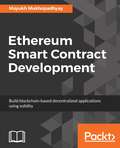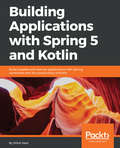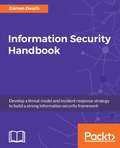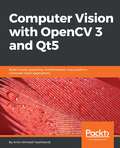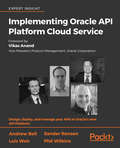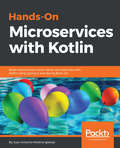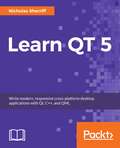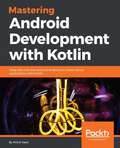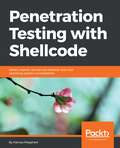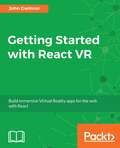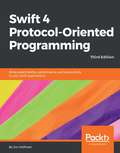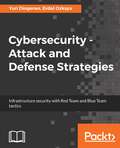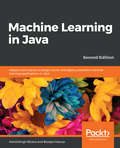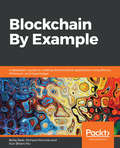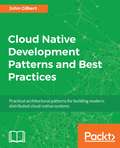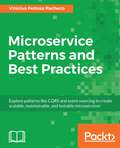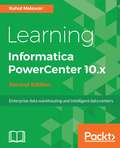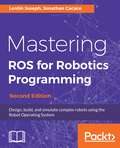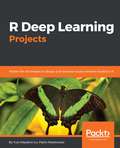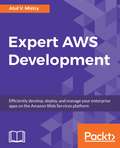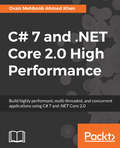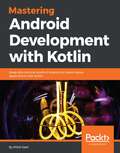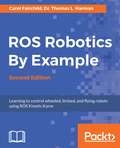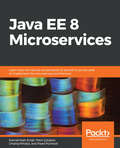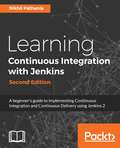- Table View
- List View
Ethereum Smart Contract Development: Build Blockchain-based Decentralized Applications Using Solidity
by Mayukh Mukhopadhyay<P><P>Become an Ethereum Blockchain developer using a blend of concepts and hands-on implementations <P><P>Key Features <P><P>Understand the Ethereum Ecosystem and its differences from its rich cousin Bitcoin <P><P>Explore the Solidity programming language and smart contract optimizations <P><P>Get a developer’s perspective of Blockchain-as-a-technology with exposure to common challenges faced while building decentralized applications <P><P>Book Description <P><P>Ethereum is a public, blockchain-based distributed computing platform featuring smart contract functionality. This book is your one-stop guide to blockchain and Ethereum smart contract development. <P><P>We start by introducing you to the basics of blockchain. You'll learn about hash functions, Merkle trees, forking, mining, and much more. Then you'll learn about Ethereum and smart contracts, and we'll cover Ethereum virtual machine (EVM) in detail. Next, you'll get acquainted with DApps and DAOs and see how they work. We'll also delve into the mechanisms of advanced smart contracts, taking a practical approach. <P><P>You'll also learn how to develop your own cryptocurrency from scratch in order to understand the business behind ICO. Further on, you'll get to know the key concepts of the Solidity programming language, enabling you to build decentralized blockchain-based applications. We'll also look at enterprise use cases, where you'll build a decentralized microblogging site. <P><P>At the end of this book, we discuss blockchain-as-a-service, the dark web marketplace, and various advanced topics so you can get well versed with the blockchain principles and ecosystem. <P><P>What you will learn <P><P>Know how to build your own smart contracts and cryptocurrencies <P><P>Understand the Solidity language <P><P>Find out about data types, control structure, functions, inheritance, mathematical operations, and much more <P><P>See the various types of forks and discover how they are related to Ethereum <P><P>Get to know the various concepts of web3.js and its APIs so you can build client-side apps <P><P>Build a DAO from scratch and acquire basic knowledge of DApps on Ethercast <P><P>Be guided through the project so you can optimize EVM for smart contracts <P><P>Build your own decentralized applications (DApps) by taking a practical approach <P><P>Who this book is for <P><P>If you want to know the ins and outs of the Ethereum network and build your own decentralized applications, then this book is what you need! This book is for anyone who is interested in blockchain and wants to become an Ethereum developer. It’s ideal for existing Ethereum developers who want to develop Ethereum using smart contracts. Basic knowledge of cryptography is expected but is not mandatory.
Building Applications with Spring 5 and Kotlin: Build scalable and reactive applications with Spring combined with the productivity of Kotlin
by Miloš VasićLearn to build a full-fledged application in Spring and Kotlin taking a reactive, microservice-based approach for scalability and robustness in the cloudKey Features Build a full-fledged application in Spring and Kotlin Architect your application to take a microservice-based approach in the cloud Integrate your application with a variety of Spring componentsBook DescriptionKotlin is being used widely by developers because of its light weight, built-in null safety, and functional and reactive programming aspects. Kotlin shares the same pragmatic, innovative and opinionated mindset as Spring, so they work well together. Spring when combined with Kotlin helps you to reach a new level of productivity. This combination has helped developers to create Functional Applications using both the tools together. This book will teach you how to take advantage of these developments and build robust, scalable and reactive applications with ease. In this book, you will begin with an introduction to Spring and its setup with Kotlin. You will then dive into assessing the design considerations of your application. Then you will learn to use Spring (with Spring Boot) along with Kotlin to build a robust backend in a microservice architecture with a REST based collaboration, and leverage Project Reactor in your application. You’ll then learn how to integrate Spring Data and Spring Cloud to manage configurations for database interaction and cloud deployment. You’ll also learn to use Spring Security to beef up security of your application before testing it with the JUnit framework and then deploying it on a cloud platform like AWS. What you will learn Explore Spring 5 concepts with Kotlin Learn both dependency injections and complex configurations Utilize Spring Data, Spring Cloud, and Spring Security in your applications Create efficient reactive systems with Project Reactor Write unit tests for your Spring/Kotlin applications Deploy applications on cloud platforms like AWSWho this book is forDevelopers comfortable using Spring who have basic knowledge of Kotlin and want to take their development skills to the next level and build enterprise-grade applications will benefit from this book.
Information Security Handbook
by Darren DeathImplement information security effectively as per your organization's needs. About This Book • Learn to build your own information security framework, the best fit for your organization • Build on the concepts of threat modeling, incidence response, and security analysis • Practical use cases and best practices for information security Who This Book Is For This book is for security analysts and professionals who deal with security mechanisms in an organization. If you are looking for an end to end guide on information security and risk analysis with no prior knowledge of this domain, then this book is for you. What You Will Learn • Develop your own information security framework • Build your incident response mechanism • Discover cloud security considerations • Get to know the system development life cycle • Get your security operation center up and running • Know the various security testing types • Balance security as per your business needs • Implement information security best practices In Detail Having an information security mechanism is one of the most crucial factors for any organization. Important assets of organization demand a proper risk management and threat model for security, and so information security concepts are gaining a lot of traction. This book starts with the concept of information security and shows you why it's important. It then moves on to modules such as threat modeling, risk management, and mitigation. It also covers the concepts of incident response systems, information rights management, and more. Moving on, it guides you to build your own information security framework as the best fit for your organization. Toward the end, you'll discover some best practices that can be implemented to make your security framework strong. By the end of this book, you will be well-versed with all the factors involved in information security, which will help you build a security framework that is a perfect fit your organization's requirements. Style and approach This book takes a practical approach, walking you through information security fundamentals, along with information security best practices.
Computer Vision with OpenCV 3 and Qt5: Build visually appealing, multithreaded, cross-platform computer vision applications
by Amin Ahmadi Tazehkandi Karl Phillip Buhr Vinícius GodoyKey Features ● Start creating robust applications with the power of OpenCV and Qt combined ● Learn from scratch how to develop cross-platform computer vision applications ● Accentuate your OpenCV applications by developing them with Qt Book Description Developers have been using OpenCV library to develop computer vision applications for a long time. However, they now need a more effective tool to get the job done and in a much better and modern way. Qt is one of the major frameworks available for this task at the moment. This book will teach you to develop applications with the combination of OpenCV 3 and Qt5. This book will teach you to create cross-platform computer vision applications. We’ll begin by introducing Qt, its IDE, and its SDK. Next you’ll learn how to use the OpenCV API to integrate both tools, and see how to configure Qt to use OpenCV. You’ll go on to build a full-fledged computer vision application throughout the book. Later, you’ll create a stunning UI application using the Qt widgets technology, where you’ll display the images after they are processed in an efficient way. At the end of the book, you’ll learn how to convert OpenCV Mat to Qt QImage. You’ll also see how to efficiently process images to filter them, transform them, detect or track objects as well as analyze video. You’ll become better at developing OpenCV applications. What you will learn ● Get an introduction to Qt IDE and SDK ● Be introduced to OpenCV and see how to communicate between OpenCV and Qt ● Understand how to create UI using Qt Widgets ● Know to develop cross-platform applications using OpenCV 3 and Qt 5 ● Explore the multithreaded application development features of Qt5 ● Improve OpenCV 3 application development using Qt5 ● Build, test, and deploy Qt and OpenCV apps, either dynamically or statically ● See Computer Vision technologies such as filtering and transformation of images, detecting and matching objects, template matching, object tracking, video and motion analysis, and much more ● Be introduced to QML and Qt Quick for iOS and Android application development
Implementing Oracle API Platform Cloud Service: Design, deploy, and manage your APIs in Oracle’s new API Platform
by Andrew Bell Phil Wilkins Sander Rensen Luis WeirWork with the newest Oracle API Platform Cloud Service to interface with the increasingly complex array of services your clients want.Key Features Understand the architecture and functionality of the new Oracle API Cloud Service Platform Understand typical use cases for the new platform and how it can work for you Design your own APIs, then deploy and customize your APIs Implement Oauth 2.0 policy and custom policies Migrate from Oracle 12c solutions to the new Oracle API platformBook DescriptionImplementing Oracle API Platform Cloud Service moves from theory to practice using the newest Oracle API management platform. This critical new platform for Oracle developers allows you to interface the complex array of services your clients expect in the modern world.First, you'll learn about Oracle’s new platform and get an overview of it, then you'll see a use case showing the functionality and use of this new platform for Oracle customers. Next, you’ll see the power of Apiary and begin designing your own APIs. From there, you’ll build and run microservices and set up the Oracle API gateways. Moving on, you’ll discover how to customize the developer portal and publish your own APIs. You’ll spend time looking at configuration management on the new platform, and implementing the Oauth 2.0 policy, as well as custom policies. The latest finance modules from Oracle will be examined, with some of the third party alternatives in sight as well.This broad-scoped book completes your journey with a clear examination of how to transition APIs from Oracle API Management 12c to the new Oracle API Platform, so that you can step into the future confidently.What you will learn Get an overview of the Oracle API Cloud Service Platform See typical use cases of the Oracle API Cloud Service Platform Design your own APIs using Apiary Build and run microservices Set up API gateways with the new API platform from Oracle Customize developer portals Configuration management Implement Oauth 2.0 policies Implement custom policies Get a policy SDK overview Transition from Oracle API Management 12c to the new Oracle API platformWho this book is forThis book is for all Oracle developers who are working or plan to work with the Oracle API Platform Cloud Service.
Hands-On Microservices with Kotlin: Build reactive and cloud-native microservices with Kotlin using Spring 5 and Spring Boot 2.0
by Juan Antonio Medina IglesiasBuild smart, efficient, and fast enterprise-grade web implementation of the microservices architecture that can be easily scaled. Key Features Write easy-to-maintain lean and clean code with Kotlin for developing better microservices Scale your Microserivces in your own cloud with Docker and Docker Swarm Explore Spring 5 functional reactive web programming with Spring WebFlux Book Description With Google's inclusion of first-class support for Kotlin in their Android ecosystem, Kotlin's future as a mainstream language is assured. Microservices help design scalable, easy-to-maintain web applications; Kotlin allows us to take advantage of modern idioms to simplify our development and create high-quality services. With 100% interoperability with the JVM, Kotlin makes working with existing Java code easier. Well-known Java systems such as Spring, Jackson, and Reactor have included Kotlin modules to exploit its language features. This book guides the reader in designing and implementing services, and producing production-ready, testable, lean code that's shorter and simpler than a traditional Java implementation. Reap the benefits of using the reactive paradigm and take advantage of non-blocking techniques to take your services to the next level in terms of industry standards. You will consume NoSQL databases reactively to allow you to create high-throughput microservices. Create cloud-native microservices that can run on a wide range of cloud providers, and monitor them. You will create Docker containers for your microservices and scale them. Finally, you will deploy your microservices in OpenShift Online. What you will learn Understand microservice architectures and principles Build microservices in Kotlin using Spring Boot 2.0 and Spring Framework 5.0 Create reactive microservices that perform non-blocking operations with Spring WebFlux Use Spring Data to get data reactively from MongoDB Test effectively with JUnit and Kotlin Create cloud-native microservices with Spring Cloud Build and publish Docker images of your microservices Scaling microservices with Docker Swarm Monitor microservices with JMX Deploy microservices in OpenShift Online Who this book is for If you are a Kotlin developer with a basic knowledge of microservice architectures and now want to effectively implement these services on enterprise-level web applications, then this book is for you
Learn Qt 5: Build modern, responsive cross-platform desktop applications with Qt, C++, and QML
by Nicholas SherriffLearn the fundamentals of QT 5 framework to develop interactive cross-platform applications Key Features A practical guide on the fundamentals of application development with QT 5 Learn to write scalable, robust and adaptable C++ code with QT Deploy your application on different platforms such as Windows, Mac OS, and Linux Book Description Qt is a mature and powerful framework for delivering sophisticated applications across a multitude of platforms. It has a rich history in the Linux world, is widely used in embedded devices, and has made great strides in the Mobile arena over the past few years. However, in the Microsoft Windows and Apple Mac OS X worlds, the dominance of C#/.NET and Objective-C/Cocoa means that Qt is often overlooked. This book demonstrates the power and flexibility of the Qt framework for desktop application development and shows how you can write your application once and deploy it to multiple operating systems. Build a complete real-world line of business (LOB) solution from scratch, with distinct C++ library, QML user interface, and QtTest-driven unit-test projects. This is a suite of essential techniques that cover the core requirements for most LOB applications and will empower you to progress from a blank page to shipped application. What you will learn · Install and configure the Qt Framework and Qt Creator IDE · Create a new multi-project solution from scratch and control every aspect of it with QMake · Implement a rich user interface with QML · Learn the fundamentals of QtTest and how to integrate unit testing · Build self-aware data entities that can serialize themselves to and from JSON · Manage data persistence with SQLite and CRUD operations · Reach out to the internet and consume an RSS feed · Produce application packages for distribution to other usersWho this book is for This book is for application developers who want a powerful and flexible framework to create modern, responsive applications on Microsoft Windows, Apple Mac OS X, and Linux desktop platforms. You should be comfortable with C++ but no prior knowledge of Qt or QML is required.
Mastering Android Development with Kotlin
by Miloš VasićKotlin is a programming language intended to be a better Java, and it is designed to be usable and readable across large teams with different levels of knowledge. Kotlin gives more to Android than Java ever did. With this book, you will learn how to create effective and modern applications using a cutting edge programming language. We’ll teach you Android from novice to master level, and guide you to become an experienced Android developer
Penetration Testing with Shellcode: Detect, Exploit, And Secure Network-level And Operating System Vulnerabilities
by Hamza MegahedSecurity has always been a major concern for your application, your system, or your environment. This book's main goal is to build your skills for low-level security exploits, finding vulnerabilities and covering loopholes with shellcode, assembly, and Metasploit.
Getting Started with React VR
by John GwinnerCreate amazing 360 and virtual reality content that runs directly in your browsers with JavaScript and React VR 2.0 About This Book • A practical guide to developing virtual reality experiences targeting web and mobile browsers • Create customized 3D graphics for your virtual reality experiences with Three.js • Explore the ReactVR library to create objects that seem real and see how they move in the Virtual world • Import free models into VR and include those in your code Who This Book Is For This book is for web developers who want to use their existing skill set of HTML, CSS, and JavaScript to create virtual reality experiences. What You Will Learn • Use Blender 2.79 to make virtual reality objects for Web VR. • Import free models into VR and how to include those in your code • Build a Virtual Museum with interactive art pieces • Create your first VR App and customizing it • Build animations by procedurally changing an object's position, using timers and Animated APIs • Incorporate React Native code and JavaScript code in your VR world In Detail This book takes you on a journey to create intuitive and interactive Virtual Reality experiences by creating your first VR application using React VR 2.0.0. It starts by getting you up to speed with Virtual Reality (VR) and React VR components. It teaches you what Virtual Reality (VR) really is, why it works, how to describe 3D objects, the installation of Node.js (version 9.2.0) and WebVR browser. You will learn 3D polygon modeling, texturing, animating virtual objects and adding sound to your VR world. You will also discover ways to extend React VR with new features and native Three.js. You will learn how to include existing high-performance web code into your VR app. This book will also take you through upgrading and publishing your app. By the end of this book, you'll have a deep knowledge of Virtual Reality and a full-fledged working VR app to add to your profile! Style and approach A step-by-step practical guide to help readers build their first VR application.
Swift 4 Protocol-Oriented Programming - Third Edition
by Jon HoffmanBuild fast and powerful applications by harnessing the power of protocol-oriented programming in Swift 4 About This Book • Leverage the power of protocol-oriented programming in your applications and learn from real-world use cases • Create a flexible code base with protocols and protocol extensions • Leverage the power of generics in Swift 4 to create very flexible frameworks Who This Book Is For This book is for Swift developers who want to learn and implement protocol-oriented programming in their real-world applications.. What You Will Learn • Understand the differences between object-oriented programming and protocol-oriented programming • Explore the different types that Swift offers and what pitfalls to avoid • Delve into generics and generic programming • Learn how to implement Copy-On-Write within your custom types • Implement several design patterns in a protocol-oriented way • Design applications by prioritizing the protocol first and the implementation types second In Detail Swift has become the number one language used in iOS and macOS development. The Swift standard library is developed using protocol-oriented programming techniques, generics, and first-class value semantics; therefore, every Swift developer should understand these powerful concepts and how to take advantage of them in their application design. This book will help you understand the differences between object-oriented programming and protocol-oriented programming. It will demonstrate how to work with protocol-oriented programming using real-world use cases. You will gain a solid knowledge of the various types that can be used in Swift and the differences between value and reference types. You will be taught how protocol-oriented programming techniques can be used to develop very flexible and easy-to-maintain code. By the end of the book, you will have a thorough understanding of protocol-oriented programming and how to utilize it to build powerful and practical applications. Style and approach This book is written for developers who learn best by working with code, so every concept discussed in this book is reinforced with real code examples.
Cybersecurity – Attack and Defense Strategies: Infrastructure security with Red Team and Blue Team tactics
by Yuri Diogenes Erdal OzkayaEnhance your organization’s secure posture by improving your attack and defense strategies Key Features Gain a clear understanding of the attack methods, and patterns to recognize abnormal behavior within your organization with Blue Team tactics. Learn to unique techniques to gather exploitation intelligence, identify risk and demonstrate impact with Red Team and Blue Team strategies. A practical guide that will give you hands-on experience to mitigate risks and prevent attackers from infiltrating your system. Book Description The book will start talking about the security posture before moving to Red Team tactics, where you will learn the basic syntax for the Windows and Linux tools that are commonly used to perform the necessary operations. You will also gain hands-on experience of using new Red Team techniques with powerful tools such as python and PowerShell, which will enable you to discover vulnerabilities in your system and how to exploit them. Moving on, you will learn how a system is usually compromised by adversaries, and how they hack user's identity, and the various tools used by the Red Team to find vulnerabilities in a system. In the next section, you will learn about the defense strategies followed by the Blue Team to enhance the overall security of a system. You will also learn about an in-depth strategy to ensure that there are security controls in each network layer, and how you can carry out the recovery process of a compromised system. Finally, you will learn how to create a vulnerability management strategy and the different techniques for manual log analysis. By the end of this book, you will be well-versed with Red Team and Blue Team techniques and will have learned the techniques used nowadays to attack and defend systems. What you will learn Learn the importance of having a solid foundation for your security posture Understand the attack strategy using cyber security kill chain Learn how to enhance your defense strategy by improving your security policies, hardening your network, implementing active sensors, and leveraging threat intelligence Learn how to perform an incident investigation Get an in-depth understanding of the recovery process Understand continuous security monitoring and how to implement a vulnerability management strategy Learn how to perform log analysis to identify suspicious activitiesWho this book is for This book aims at IT professional who want to venture the IT security domain. IT pentester, Security consultants, and ethical hackers will also find this course useful. Prior knowledge of penetration testing would be beneficial.
Machine Learning in Java: Helpful techniques to design, build, and deploy powerful machine learning applications in Java, 2nd Edition
by Bostjan Kaluza AshishSingh BhatiaLeverage the power of Java and its associated machine learning libraries to build powerful predictive models Key Features *Solve predictive modeling problems using the most popular machine learning Java libraries *Explore data processing, machine learning, and NLP concepts using JavaML, WEKA, MALLET libraries *Practical examples, tips, and tricks to help you understand applied machine learning in Java Book Description As the amount of data in the world continues to grow at an almost incomprehensible rate, being able to understand and process data is becoming a key differentiator for competitive organizations. Machine learning applications are everywhere, from self-driving cars, spam detection, document search, and trading strategies, to speech recognition. This makes machine learning well-suited to the present-day era of big data and Data Science. The main challenge is how to transform data into actionable knowledge. Machine Learning in Java will provide you with the techniques and tools you need. You will start by learning how to apply machine learning methods to a variety of common tasks including classification, prediction, forecasting, market basket analysis, and clustering. The code in this book works for JDK 8 and above, the code is tested on JDK 11. Moving on, you will discover how to detect anomalies and fraud, and ways to perform activity recognition, image recognition, and text analysis. By the end of the book, you will have explored related web resources and technologies that will help you take your learning to the next level. By applying the most effective machine learning methods to real-world problems, you will gain hands-on experience that will transform the way you think about data. What you will learn *Discover key Java machine learning libraries *Implement concepts such as classification, regression, and clustering *Develop a customer retention strategy by predicting likely churn candidates *Build a scalable recommendation engine with Apache Mahout *Apply machine learning to fraud, anomaly, and outlier detection *Experiment with deep learning concepts and algorithms *Write your own activity recognition model for eHealth applications Who this book is for If you want to learn how to use Java's machine learning libraries to gain insight from your data, this book is for you. It will get you up and running quickly and provide you with the skills you need to successfully create, customize, and deploy machine learning applications with ease. You should be familiar with Java programming and some basic data mining concepts to make the most of this book, but no prior experience with machine learning is required.
Blockchain By Example: A developer's guide to creating decentralized applications using Bitcoin, Ethereum, and Hyperledger
by Bellaj BadrIf you are keen on learning how to build blockchain decentralized applications from scratch, then this book is what you need. It explains all the basic concepts required to develop your own intermediate projects.
Cloud Native Development Patterns and Best Practices: Practical Architectural Patterns For Building Modern, Distributed Cloud-native Systems
by John Gilbert<P><P>Learn to apply cloud-native patterns and practices to deliver responsive, resilient, elastic, and message-driven systems with confidence <P><P>Key Features <P><P>Understand the architectural patterns involved in cloud-native architectures <P><P>Minimize risk by evolving your monolithic applications into distributed cloud-native systems <P><P>Discover best practices for applying cloud-native patterns to your enterprise-level cloud applications <P><P>Book Description <P><P>Build systems that leverage the benefits of the cloud and applications faster than ever before with cloud-native development. This book focuses on architectural patterns for building highly scalable cloud-native systems. You will learn how the combination of cloud, reactive principles, devops, and automation enable teams to continuously deliver innovation with confidence. <P><P>Begin by learning the core concepts that make these systems unique. You will explore foundational patterns that turn your database inside out to achieve massive scalability with cloud-native databases. You will also learn how to continuously deliver production code with confidence by shifting deployment and testing all the way to the left and implementing continuous observability in production. There's more-you will also learn how to strangle your monolith and design an evolving cloud-native system. <P><P>By the end of the book, you will have the ability to create modern cloud-native systems. <P><P>What you will learn <P><P>Enable massive scaling by turning your database inside out <P><P>Unleash flexibility via event streaming <P><P>Leverage polyglot persistence and cloud-native databases <P><P>Embrace modern continuous delivery and testing techniques <P><P>Minimize risk by evolving your monoliths to cloud-native <P><P>Apply cloud-native patterns and solve major architectural problems in cloud environment <P><P>Who This Book Is For <P><P>This book is for developers who would like to progress into building cloud-native systems and are keen to learn the patterns involved. Basic knowledge of programming and cloud computing is required.
Microservice Patterns and Best Practices: Explore Patterns Like Cqrs And Event Sourcing To Create Scalable, Maintainable, And Testable Microservices
by Vinicius Feitosa PachecoMicroservices are a hot trend in the development world right now. Many enterprises have adopted this approach to achieve agility and the continuous delivery of applications to gain a competitive advantage. This book will take you through the different design patterns at different stages of the microservice application development process, along with best practices.
Learning Informatica PowerCenter 10.x - Second Edition
by Rahul MalewarHarness the power and simplicity of Informatica PowerCenter 10.x to build and manage efficient data management solutions About This Book • Master PowerCenter 10.x components to create, execute, monitor, and schedule ETL processes with a practical approach. • An ideal guide to building the necessary skills and competencies to become an expert Informatica PowerCenter developer. • A comprehensive guide to fetching/transforming and loading huge volumes of data in a very effective way, with reduced resource consumption Who This Book Is For If you wish to deploy Informatica in enterprise environments and build a career in data warehousing, then this book is for you. Whether you are a software developer/analytic professional and are new to Informatica or an experienced user, you will learn all the features of Informatica 10.x. A basic knowledge of programming and data warehouse concepts is essential. What You Will Learn • Install or upgrade the components of the Informatica PowerCenter tool • Work on various aspects of administrative skills and on the various developer Informatica PowerCenter screens such as Designer, Workflow Manager, Workflow Monitor, and Repository Manager. • Get practical hands-on experience of various sections of Informatica PowerCenter, such as navigator, toolbar, workspace, control panel, and so on • Leverage basic and advanced utilities, such as the debugger, target load plan, and incremental aggregation to process data • Implement data warehousing concepts such as schemas and SCDs using Informatica • Migrate various components, such as sources and targets, to another region using the Designer and Repository Manager screens • Enhance code performance using tips such as pushdown optimization and partitioning In Detail Informatica PowerCenter is an industry-leading ETL tool, known for its accelerated data extraction, transformation, and data management strategies. This book will be your quick guide to exploring Informatica PowerCenter's powerful features such as working on sources, targets, transformations, performance optimization, scheduling, deploying for processing, and managing your data at speed. First, you'll learn how to install and configure tools. You will learn to implement various data warehouse and ETL concepts, and use PowerCenter 10.x components to build mappings, tasks, workflows, and so on. You will come across features such as transformations, SCD, XML processing, partitioning, constraint-based loading, Incremental aggregation, and many more. Moreover, you'll also learn to deliver powerful visualizations for data profiling using the advanced monitoring dashboard functionality offered by the new version. Using data transformation technique, performance tuning, and the many new advanced features, this book will help you understand and process data for training or production purposes. The step-by-step approach and adoption of real-time scenarios will guide you through effectively accessing all core functionalities offered by Informatica PowerCenter version 10.x. Style and approach You'll get hand-on with sources, targets, transformations, performance optimization, scheduling, deploying for processing, and managing your data, and learn everything you need to become a proficient Informatica PowerCenter developer.
Mastering ROS for Robotics Programming, Second Edition: Design, build, and simulate complex robots using the Robot Operating System, 2nd Edition
by Jonathan Cacace Lentin JosephDiscover best practices and troubleshooting solutions when working on ROS Key Features Develop complex robotic applications using ROS to interface robot manipulators and mobile robots Gain insight into autonomous navigation in mobile robots and motion planning in robot manipulators Discover best practices and troubleshooting solutions Book Description In this day and age, robotics has been gaining a lot of traction in various industries where consistency and perfection matter. Automation is achieved via robotic applications and various platforms that support robotics. The Robot Operating System (ROS) is a modular software platform to develop generic robotic applications. This book focuses on the most stable release of ROS (Kinetic Kame), discusses advanced concepts, and effectively teaches you programming using ROS. We begin with aninformative overview of the ROS framework, which will give you a clear idea of how ROS works. During the course of this book, you’ll learn to build models of complex robots, and simulate and interface the robot using the ROS MoveIt! motion planning library and ROS navigation stacks. Learn to leverage several ROS packages to embrace your robot models. After covering robot manipulation and navigation, you’ll get to grips with the interfacing I/O boards, sensors, and actuators of ROS. Vision sensors are a key component of robots, and an entire chapter is dedicated to the vision sensor and image elaboration, its interface in ROS and programming. You’ll also understand the hardware interface and simulation of complex robots to ROS and ROS Industrial. At the end of this book, you’ll discover the best practices to follow when programming using ROS. What you will learn Create a robot model with a seven-DOF robotic arm and a differential wheeled mobile robot Work with Gazebo and V-REP robotic simulator Implement autonomous navigation in differential drive robots using SLAM and AMCL packages Explore the ROS Pluginlib, ROS nodelets, and Gazebo plugins Interface I/O boards such as Arduino, robot sensors, and high-end actuators Simulate and motion plan an ABB and universal arm using ROS Industrial Explore the latest version of the ROS framework Work with the motion planning of a seven-DOF arm using MoveIt!Who this book is for If you are a robotics enthusiast or researcher who want to learn more about building robot applications using ROS, this book is for you. In order to learn from this book, you should have a basic knowledge of ROS, GNU/Linux, and C++ programming concepts. The book is also excellent for programmers who want to explore the advanced features of ROS.
R Deep Learning Projects: Master the techniques to design and develop neural network models in R
by Yuxi Hayden Liu Pablo Maldonado5 real-world projects to help you master deep learning concepts Key Features Master the different deep learning paradigms and build real-world projects related to text generation, sentiment analysis, fraud detection, and more Get to grips with R's impressive range of Deep Learning libraries and frameworks such as deepnet, MXNetR, Tensorflow, H2O, Keras, and text2vec Practical projects that show you how to implement different neural networks with helpful tips, tricks, and best practices Book Description R is a popular programming language used by statisticians and mathematicians for statistical analysis, and is popularly used for deep learning. Deep Learning, as we all know, is one of the trending topics today, and is finding practical applications in a lot of domains. This book demonstrates end-to-end implementations of five real-world projects on popular topics in deep learning such as handwritten digit recognition, traffic light detection, fraud detection, text generation, and sentiment analysis. You'll learn how to train effective neural networks in R—including convolutional neural networks, recurrent neural networks, and LSTMs—and apply them in practical scenarios. The book also highlights how neural networks can be trained using GPU capabilities. You will use popular R libraries and packages—such as MXNetR, H2O, deepnet, and more—to implement the projects. By the end of this book, you will have a better understanding of deep learning concepts and techniques and how to use them in a practical setting. What you will learn - Instrument Deep Learning models with packages such as deepnet, MXNetR, Tensorflow, H2O, Keras, and text2vec - Apply neural networks to perform handwritten digit recognition using MXNet - Get the knack of CNN models, Neural Network API, Keras, and TensorFlow for traffic sign classification -Implement credit card fraud detection with Autoencoders -Master reconstructing images using variational autoencoders - Wade through sentiment analysis from movie reviews - Run from past to future and vice versa with bidirectional Long Short-Term Memory (LSTM) networks - Understand the applications of Autoencoder Neural Networks in clustering and dimensionality reductionWho this book is for Machine learning professionals and data scientists looking to master deep learning by implementing practical projects in R will find this book a useful resource. A knowledge of R programming and the basic concepts of deep learning is required to get the best out of this book.
Expert AWS Development: Efficiently develop, deploy, and manage your enterprise apps on the Amazon Web Services platform
by Atul MistryKey concepts, sample applications, best practices, and troubleshooting tips to build highly scalable applications in AWS. Key FeaturesDesign highly available, cost efficient, fault tolerant, and scalable distributed systemsA practical guide that will help you build, deploy, and manage applications with ease.Develop effective solutions with AWS SDK and LambdaBook DescriptionContinuous deployment and Agile methodology have enabled huge advances in modern applications. This book will enable the reader to make use of this rapidly evolving technology to build highly scalable applications within AWS using different architectures.You will begin with installation of AWS SDK and you will get hands-on experience on creating an application using AWS Management Console and AWS Command Line Interface (CLI). Next you will be integrating Applications with AWS services such as DynamoDB, Amazon Kinesis, AWS Lambda, Amazon SQS and Amazon SWFFollowing this you will get well versed with CI/CD workflow and work with four major phases in Release processes – Source, Build, Test and Production. Next you will learn to apply AWS developer tools in your Continuous Integration (CI) and Continuous Deployment (CD) WorkFlow. Later you will learn about User Authentication using Amazon Cognito and also how you can evaluate the best architecture as per your infrastructure costs. You will learn about Amazon EC2 service and deploy an app using Amazon EC2.You will also get well versed with container service which is Amazon EC2 Container Service (Amazon ECS) and you will learn to deploy an app using Amazon ECS. Along with EC2 and ECS, you will also deploying a practical real-world example of a CI/CD application with the Serverless Application Framework which is known as AWS Lambda. Finally you will learn how to build, develop and deploy the Application using AWS Developer tools like AWS CodeCommit, AWS CodeBuild, AWS CodeDeploy and AWS CodePipeline as per project needs. Also you can develop and deploy applications within minutes using AWS CodeStar from wizard.By the end of this book, the reader will effectively build, deploy, and manage applications on AWS along with scaling and securing applications with best practices and troubleshooting tips.What you will learnLearn how to get up and running with AWS Developer Tools.Integrate the four major phases in the Release Processes. Source, Build, Test and Production.Learn how to integrate Continuous Integration, Continuous Delivery, and Continuous Deployment in AWS.Make secure, scalable and fault tolerant applications.Understand different architectures and deploy complex architectures within minutesWho this book is forThis book targets developers who would like to build and manage web and mobile applications and services on the AWS platform. If you are an architect you will be able to take a deep dive and use examples that can be readily applied to real world scenarios. Some prior programming experience is assumed along with familiarity of cloud computing.
C# 7 and .NET Core 2.0 High Performance: Build highly performant, multi-threaded, and concurrent applications using C# 7 and .NET Core 2.0
by Ovais Mehboob Ahmed KhanImprove the speed of your code and optimize the performance of your appsKey FeaturesUnderstand the common performance pitfalls and improve your application’s performanceGet to grips with multi-threaded and asynchronous programming in C#Develop highly performant applications on .NET Core using microservice architectureBook DescriptionWhile writing an application, performance is paramount. Performance tuning for realworld applications often involves activities geared toward fnding bottlenecks; however, this cannot solve the dreaded problem of slower code. If you want to improve the speed of your code and optimize an application's performance, then this book is for you. C# 7 and .NET Core 2.0 High Performance begins with an introduction to the new features of what?explaining how they help in improving an application's performance. Learn to identify the bottlenecks in writing programs and highlight common performance pitfalls, and learn strategies to detect and resolve these issues early. You will explore multithreading and asynchronous programming with .NET Core and learn the importance and effcient use of data structures. This is followed with memory management techniques and design guidelines to increase an application’s performance. Gradually, the book will show you the importance of microservices architecture for building highly performant applications and implementing resiliency and security in .NET Core. After reading this book, you will learn how to structure and build scalable, optimized, and robust applications in C#7 and .NET.What you will learn Measure application performance using BenchmarkDotNet Explore the techniques to write multithreaded applications Leverage TPL and PLinq libraries to perform asynchronous operations Get familiar with data structures to write optimized code Understand design techniques to increase your application’s performance Learn about memory management techniques in .NET Core Develop a containerized application based on microservices architecture Learn tools and techniques to monitor application performanceWho this book is forThis book is for .NET developers looking at improving the speed of their code or simply wanting to take their skills to the next level. Basic C# knowledge is assumed.
Mastering Android Development with Kotlin: Deep dive into the world of Android to create robust applications with Kotlin
by Milos VasicMaster Android development using a variety of Kotlin features About This Book • Leverage specific features of Kotlin to ease Android application development • An illustrative guide that will help you write code based Kotlin language to build robust Android applications • Filled with various practical examples build amazing Android project using Kotlin so you can easily apply your knowledge to real world scenarios Who This Book Is For The book is for developers who want to build amazing Android applications in an easy and effective way. Basic knowledge of Kotlin is assumed, but you do not need any familiarity with Android development. What You Will Learn • Understand the basics of Android development with Kotlin • Get to know the key concepts in Android development • See how to create modern mobile applications for the Android platform • Adjust your application's look and feel • Know how to persist and share application database • Work with Services and other concurrency mechanisms • Write effective tests • Migrate an existing Java-based project to Kotlin In Detail Kotlin is a programming language intended to be a better Java, and it's designed to be usable and readable across large teams with different levels of knowledge. As a language, it helps developers build amazing Android applications in an easy and effective way. This book begins by giving you a strong grasp of Kotlin's features in the context of Android development and its APIs. Moving on, you'll take steps toward building stunning applications for Android. The book will show you how to set up the environment, and the difficulty level will grow steadily with the applications covered in the upcoming chapters. Later on, the book will introduce you to the Android Studio IDE, which plays an integral role in Android development. We'll use Kotlin's basic programming concepts such as functions, lambdas, properties, object-oriented code, safety aspects, type parameterization, testing, and concurrency, which will guide you through writing Kotlin code into production. We'll also show you how to integrate Kotlin into any existing Android project. Style and approach In this book, you'll master Android development using Kotlin through real application examples. We'll introduce you to basic Android concepts and offer guidance from the first steps to the final project. In each chapter, we'll develop one important application functionality as a development milestone. As we progress, you'll become more experienced in Android and our application will progress toward a real-world product. Finally, when we complete the application's development, we'll write proper tests to ensure it's production ready.
ROS Robotics By Example - Second Edition
by Carol Fairchild Dr Thomas HarmanLearning how to build and program your own robots with the most popular open source robotics programming framework About This Book • Get to know the fundamentals of ROS and apply its concepts to real examples • Learn how to write robotics applications without getting bogged down in hardware problems • Learn to implement best practices in ROS development Who This Book Is For This book is for robotic enthusiasts, researchers and professional robotics engineers who would like to build robot applications using ROS. It gives the robotics beginner and the ROS newbie an immensely practical introduction to robot building and robotics application coding. Basic knowledge of GNU/Linux and the ability to write simple applications is assumed, but no robotics knowledge, practical or theoretical, is needed. What You Will Learn • Control a robot without requiring a PhD in robotics • Simulate and control a robot arm • Control a flying robot • Send your robot on an independent mission • Learning how to control your own robots with external devices • Program applications running on your robot • Extend ROS itself • Extend ROS with the MATLAB Robotics System Toolbox In Detail ROS is a robust robotics framework that works regardless of hardware architecture or hardware origin. It standardizes most layers of robotics functionality from device drivers to process control and message passing to software package management. But apart from just plain functionality, ROS is a great platform to learn about robotics itself and to simulate, as well as actually build, your first robots. This does not mean that ROS is a platform for students and other beginners; on the contrary, ROS is used all over the robotics industry to implement flying, walking and diving robots, yet implementation is always straightforward, and never dependent on the hardware itself. ROS Robotics has been the standard introduction to ROS for potential professionals and hobbyists alike since the original edition came out; the second edition adds a gradual introduction to all the goodness available with the Kinetic Kame release. By providing you with step-by-step examples including manipulator arms and flying robots, the authors introduce you to the new features. The book is intensely practical, with space given to theory only when absolutely necessary. By the end of this book, you will have hands-on experience on controlling robots with the best possible framework. Style and approach ROS Robotics By Example, Second Edition gives the robotics beginner as well as the ROS newbie an immensely practical introduction to robot building and robotics application coding. ROS translates as "robot operating system"; you will learn how to control a robot via devices and configuration files, but you will also learn how to write robot applications on the foundation of this operating system.
Java EE 8 Microservices
by Mert Caliskan Pavel Pscheidl Ondrej MihalyiJavaEE developers who are eager to start building enterprise applications in the microservices architecture will find this book extremely useful.
Learning Continuous Integration with Jenkins.: A beginner's guide to implementing Continuous Integration and Continuous Delivery using Jenkins 2, 2nd Edition
by Nikhil Pathania Deep MehtaKey FeaturesTake advantage of a Continuous Integration and Continuous Delivery solution to speed up productivity and achieve faster software deliverySee all the new features introduced in Jenkins 2.x, such as Pipeline as code, Multibranch pipeline, Docker Plugin, and moreLearn to implement Continuous Integration and Continuous Delivery by orchestrating multiple DevOps tools using JenkinsBook DescriptionIn past few years, agile software development has seen tremendous growth. There is a huge demand for software delivery solutions that are fast yet flexible to numerous amendments. As a result, Continuous Integration (CI) and Continuous Delivery (CD) methodologies are gaining popularity. This book starts off by explaining the concepts of CI and its significance in the Agile. Next, you'll learn how to configure and set up Jenkins in many different ways. The book exploits the concept of "pipeline as code" and various other features introduced in the Jenkins 2.x release to their full potential. We also talk in detail about the new Jenkins Blue Ocean interface and the features that help to quickly and easily create a CI pipeline. Then we dive into the various features offered by Jenkins one by one, exploiting them for CI and CD. Jenkins' core functionality and flexibility allows it to fit in a variety of environments and can help streamline the development process for all stakeholders. Next, you'll be introduced to CD and will learn how to achieve it using Jenkins. Through this book's wealth of best practices and real-world tips, you'll discover how easy it is to implement CI and CD using Jenkins.What you will learn Get to know some of the most popular ways to set up Jenkins See all the new features introduced in the latest Jenkins, such as pipeline as code, Multibranch pipeline, and more Manage users, projects, and permissions in Jenkins to ensure better security Leverage the power of plugins in Jenkins Learn how to create a CI pipeline using Jenkins Blue Ocean Create a distributed build farm using Docker and use it with Jenkins Implement CI and CD using Jenkins See the difference between CD and Continuous Deployment Understand the concepts of CI
